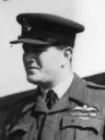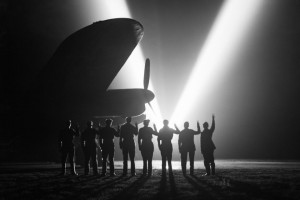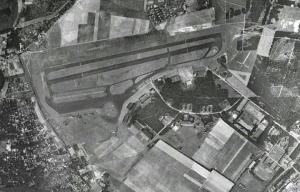156 Squadron Post War Activities
W/C A J L Craig – Commanding Officer RAF Upwood 10th April to 17th June 1945
PFF 156 Squadron Code GT-

12th June 1945 Operation ‘Cooks Tour’ Lancaster lll GT-H
Known as “Cooks Tours” out of reverence for forgotten Holiday’s Abroad, the opportunity was taken up by many Ground Crew who wished to experience Flying, many of whom had never Flown before, but more importantly allowed many of those who had Served in support of the Command’s Aircrew to see for the 1st time the damage which had been inflicted upon the Targets; to which to many had never been known of or had been merely names on a Map or spoken of during a conversation
A ‘Cooks Tour’ 22nd May 1945 – 5hrs 15mins – Lancaster GT-B
This was my last Job on 156 Squadron and also my last Flight in the Lancaster “GT-B for Beer”. The purpose of the Flight was to enable all the Members of our Crew to see a little of the devastation which has been caused by the Raids which we have taken part in. We also carried our Ground-Crew and although most of them suffered from Air-sickness they appreciated that their work in Servicing & Repairing our Aircraft and Loading Bombs and TI ‘s had not been in vain. We Flew at approx 1000-ft and visited the following places:-
Walcheran Island – Sea wall breached at Weskapelle causing Flooding of Island. Later Gun Batteries were Bombed prior to Seaborne Landing (and eventual Capture of Antwerp for use as a Supply Port.
Gilser-Ryen Aerodrome:- a German Night-fighter Airfield, which has been the cause of many of our Losses over the Channel.
Goch:- Which we Attacked on 7th February in support of the Army’.
Wesel:- The Point at which Monty’s 21st Army Group Crossed the Rhine. Attacked 7-times by RAF during February & March 1945. Severe damage occurred to Centre of Town.
Hamborn: – an outlying District North of Duisburg containing Heavy Steelworks – often Attacked – also the often battered Bruckhausen Oil & Benzol Refinery.
Duisburgh:- A Town of 443,000 Inhabitants on the East side of the Rhine – the largest Inland Port of Europe. The extensive Docks were clearly visible and absolutely chocked with Sunken & Overturned Ships & Barges. It has been Attacked 17-times by the RAF and Devastation is spread throughout the Town.
Oberhausen:- The 194,000 people who lived here are absolutely homeless.
Essen:- Famous for the Krupps Armament Works – 660,000 Inhabitants. There is very severe damage throughout the Town & Krupps Works covering 800-acres is a dump of twisted metal & rubble. It has been Raided 23-times by RAF Heavies.
Gelsen Kirchen:- The centre of the Synthetic Oil Industry. Population 332,000. Residential Area Devastated and the Oil Plants severely Damaged. This was one of the most heavily Defended places in Germany. Another Synthetic Oil Plant with severe Damage and Bomb Craters surrounding it for miles.
Dortmund:- The last of the Ruhr Towns travelling Eastwards. 550,000 Population. Famous chiefly for its Heavy Industry & Engineering Works. Important also as Communication Centre & Terminus of the Dortmund-Ems Canal. It has been attacked 16-times by Bomber Command, finally being totally Destroyed by an Attack by 1,082 Heavies on 12th March 1945, when the “Ten-Ton-Tess” was First used. Leaving the Ruhr Valley, we steered a course of 050° North towards North Germany.
Hamm:- 56,000 Inhabitants. Noted chiefly for its extensive Marshalling Yards & Railway Junction.
Bielefeld:- where the huge Railway Viaduct was blocked by a breach of about 150-yards from a near-miss by a 22,000-lbs Bomb. The Crater made by this Bomb is approx 100-yards across and was filled with water like a fair-sized Dam. The area for about a mile radius was Cratered like a pincushion.
Herford:- A small Town of 40,000 People containing various Engineering Works. Only isolated Damage.
Bad 0eynhausen Viaduct:- often damaged as part of the RAF’s Plan to disrupt Supplies.
Hildesheim:- attacked once only by 230-Lancasters which devastated the whole Town. Hannover:- An important Railway & Commercial Centre with a Population of 444,000. It has been Attacked many times by the RAF causing severe Damage, especially to the Southern part of the Town.
Missburg:- About, 5-miles East of Hannover. Famous for its Synthetic Oil Plant. It was completely put out of action by our Raid on 15th March when 260-Lancasters took part.
0snabruck:- a vital Railway Junction with Population of 100,000 inhabitants. The mainline from Berlin to Holland crosses the Line going North-East from the Ruhr to Bremen & Hamburg – numerous Attacks by both Heavies & Mosquitoes have utterly destroyed the Railway Yards, and there are 100s of Locomotives & Rail-Trucks overturned, smashed & lying about the Tracks which were torn up & scattered about like ribbons.
Munster:- This important Railway Junction has been Attacked 6-times by the American 8th Airforce. Widespread Damage was observed throughout the Town.
Emmerich: We then steered a Course due West, to Emmerich on the Rhine. About 5-miles before reaching the Rhine, we passed over the small Town of Rees which suffered severely from a heavy Artillery Barrage during the Allied Advance to Encircle the Armies Trapped in the Ruhr.
Cleves:- A small Town at the North-East Corner of the Reichwald Forest used by the Germans for the storage of Ammunition & Motor Transport. It was a key Point, together with the Town of Goch, in the Allied Advance Eastwards and was full of Troops & Armour, when Blasted out of Resistance by Bomber Command on the Night of the 7th February 1945, with Monty’s Forces only 3-miles away.
Nimegen:- The Scene of the attempted thrust to the North East leading to the bitter Fighting around Arnheim, The famous Bridges have had large Central Sections Demolished but our Engineers have kept the Roads open by placing long Bailey Bridges over the Rhine. Many wrecked & burnout Gliders were seen in the Fields near Arnheim, marking the position of the Tragic Airborne Operations when an unsuccessful attempt to take the Bridges intact was made.
Our Homeward Route crossed the Dutch Coast at the “Hague”. It was in this vicinity that many of the V2 Sites were Located. Much of Holland is still flooded but reclamation work has been commenced using 100s of Fire Pumps sent over from England.
12th July 1945 Liberty Operation Flensburg Lancaster GT-A.
During WW2 the Flensburg Airport was used by the British RAF as Advanced Landing Ground B-166 Flensburg. From D-Day until the end of WW2 Continental Airfields were identified by a letter prefix & code number:-
A = American
B = British – B.166 Flensburg/Schaferhaus 5446N 0923E
R = American Airfields in Germany
Y = American & French-occupied by Troops advancing through Southern France.
15th September 1945 – A Formation of some 300-Aircraft flies over London in the 1st Battle of Britain Anniversary Flypast. The Formation was led by 247 Squadron in their new Vampire Fighters, the 1st time the Public had seen the Aircraft. This Flypast was apparently Led by Douglas Bader.
27th September 1945 Lancaster 156 Sqdn GT-E (6.30) to Berlin – Operation Spasm
Operation ‘Spasm’ was run by Bomber Command out of RAF Mildenhall in late 1945, as some kind of sightseeing Tour over Berlin. There doesn’t seem to be much-recorded information on the Operation. These were not Tours for the General Public- they were run to allow ‘Ground Personnel‘ and others to see the damage that had been inflicted on Germany 1st hand. Three Aircraft, one of which was Piloted by the Squadron Commander, W/C A J L Craig DSO, DFC, flew to Gatow Airfield, GT-E carrying 13-Service Personnel including A/Cm Bottomley & S/L Burrel who were all permitted to stay in Berlin overnight & return the next day.
In May, the Gatow Airfield was overrun by the Red Army, who handed it over to the British Army on 2nd July 1945. Initially, Gatow was called Intermediate Landing Place No. 19, but on 19th August 1945 was renamed Royal Air Force Station Gatow, or RAF Gatow for short. RAF Gatow was on the edge of the West-Berlin zone. In fact, its closest neighbour was an East German National Peoples Army (German: Nationale Volks Armee, or NVA) Tank Battalion. The later Berlin Wall formed the Western Boundary of the Airfield, which at the Airfield was not a wall, but a wire fence. Officially this was a Military courtesy of the East German Army to the RAF (which obviously no-one believed). After the Reunification in 1990, it was found out that the Wire Fence was indeed part of an existing Attack Plan to Capture the Airfield (Operation Centre) during the 1st-hr of an Attack.

RAF Station Gatow became the Airfield for the British Sector of Berlin, and the Base for the only known Operational use of Flying Boats in Central Europe. During the Berlin Airlift, Short Flying Boats were Flying out of Lake Wannsee, operating from the Deutsch-Britischer Yacht Club in Gatow. Having been built for Operations from Seawater, they were the Planes of choice to carry much-needed Supplies of Salt to the besieged City. The Airlift made Gatow a Major Airfield, the 1st Transport Aircraft of the Airlift Landed at Gatow on 28th June 1948. Gatow also played a major role in Civilian Air Traffic, with BEA serving Berlin from 1946 until Tempelhof opened as the Civilian Airport in 1950.
Craig – RAF Wyton 17th June to 10th September 1945
RAF 35 Squadron Stradishall 18th September 21st October 1946 (1 Mth) PFF (Aged 23)



Hi, – My grandfather was F/O Frank Cheshire, and the photo on your site is one of only 2 I have ever seen.
I was hoping, I know it may be in vain, that you may know more about him, the plane (TL-L), Crew and any Combat History. I knew he was in 35 Squadron.
He passed away about a year ago, and due to family complications never really got to know him well. Just hoping you or someone else may know anything tangible about him.
Regards, – Joe
LikeLike
I was a good friend of Frank. We were billeted in the same hut at Graveley. We socialised together when 4 or 5 of us would hire a Taxi and go to St Neots and have a few beers before going to the local Dance Hall. I have a few photos taken at Graveley.
LikeLike
Hi Alan,
Thank you for your message. If you have some stories and photos I would love to hear/ see them. My email address is joe_chesh@hotmail.co.uk
LikeLike
Just in reference to Operation Spasm mentioned above, my wife’s father, Wing Commander John Dowling, also took part in this. We have a 6 sided letter dated 27th September 1945 that he wrote on Hitler’s Writing Paper having picked up the stationary in the Reich Chancellery. In it he describes the Tour in detail. There are also 6 photos from the Visit showing Personnel and the Devastation.
LikeLike
My late grandfather Archie Page flew with the 156 Sqdn. There is now a virtual War Memorial Website if any Australian Family Members are looking for Information. https://vwma.org.au/M
LikeLike